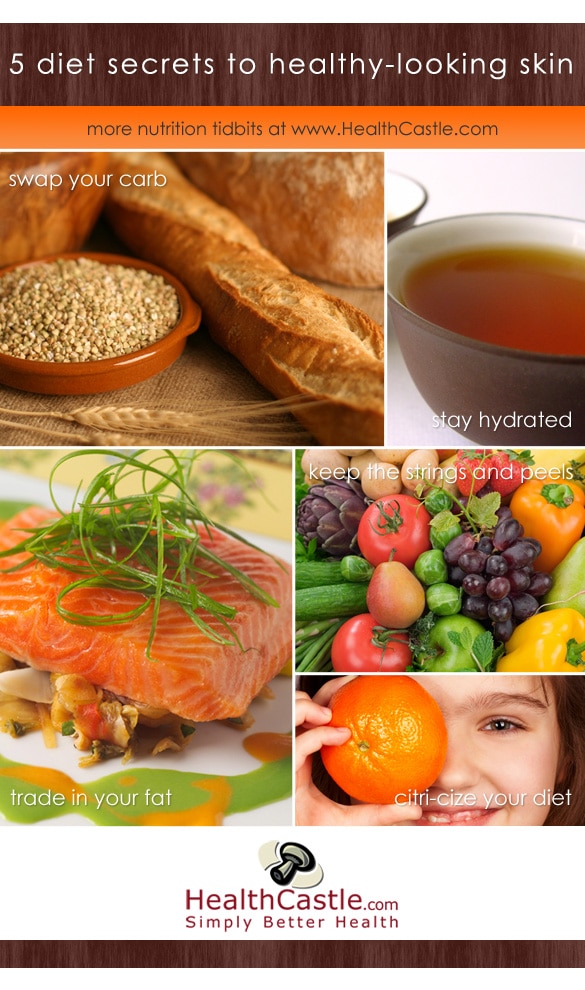
Written By: Gloria Tsang, RD
Title: Founding Registered Dietitian
Alumni: University of British Columbia
Last Updated on:

True beauty comes from within, so the key to a healthy glow may not come from your cosmetics. Your skin is the largest organ of your body. If you nourish your body from the inside out, you will make a difference in the way your skin looks – and ages.

Table of Contents
Read on for simple diet swaps that make your skin glow.

Replace refined carbohydrate foods like white bread, cookies, and pasta with their whole-grain cousins. Not only do whole grains provide a lot more anti-aging antioxidants, they also provide the key element of a healthy skin diet – fiber.
“A high-fiber diet with lots of whole grains can help eliminate toxins and act as a detoxifying agent for your body,” says nutritionist Tanya Zuckerbrot, who is currently working on her second book The Miracle Carb Diet. She recommends eating 35 grams of fiber every day.
Toss out the bad fats in your diet – saturated and trans fat – and replace them with good fats. Omega 3 fatty acids from fish sources can reduce skin cancer risk, according to nutritionist Elizabeth Somer, author of Age-Proof Your Body. She suggested eating 200 mg of DHA a day – that’s equivalent to two servings of salmon a week. While most of us get plenty of omega 6 fatty acids from our diet, Somer stressed the importance of another good fat – linoleic acid – in preventing dry, flaky skin. Linoleic acid can be found in vegetable oils like safflower oil, sunflower oil and olive oil.
Citrus fruits play an important role in keeping your skin looking young. That’s because the antioxidant Vitamin C found in citrus “is involved in the formation of collagen – a protein that binds cells and tissues together”, according to nutritionist and Food Network Chef Robin Miller. In other words, collagen helps keep your skin firm and hence reduces wrinkling. Therefore, include more Vitamin C-rich foods such as oranges, grapefruit, kiwis, strawberries, red bell peppers, and broccoli in your diet. Don’t just eat citrus as after-meal fruits – you can always include them in your dishes!
There are more health reasons to add fruits and vegetables to your diet. Silica found in plant-based foods can help maintain the elasticity of your skin and improve your complexion, suggested Chef Miller, who recently developed recipes for skin care brand VIVITÉ. What you probably don’t know is that silica is often found in parts that are often discarded – strings and peels. So if possible, enjoy the whole fruit and vegetable, like cucumber skin and the strings of celery and asparagus.
Fluids keep your skin hydrated and help flush toxins. Drink at least 6 cups of fluids – water and tea – every day. Dr. Doug Balentine, Director of Nutrition and Health with Lipton, recommends drinking black, green, and white teas for their beneficial flavonoid content. Skip the cream and sugar to make them calorie-free.
Alumni: University of British Columbia – Gloria Tsang is the author of 6 books and the founder of HealthCastle.com, the largest online nutrition network run by registered dietitians. Her work has appeared in major national publications, and she is a regularly featured nutrition expert for media outlets across the country. The Huffington Post named her one of its Top 20 Nutrition Experts on Twitter. Gloria’s articles have appeared on various media such as Reuters, NBC & ABC affiliates, The Chicago Sun-Times, Reader’s Digest Canada, iVillage and USA Today.
fat, fiber, healthy snacks, omega-3, skin